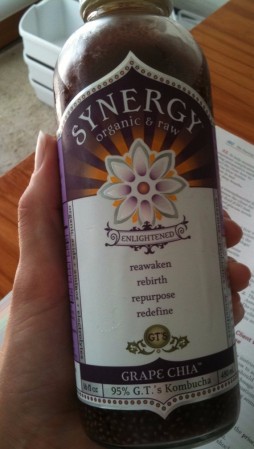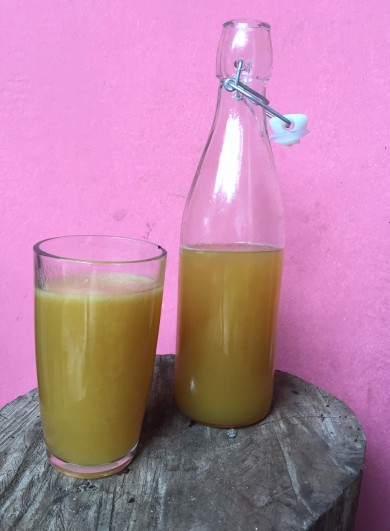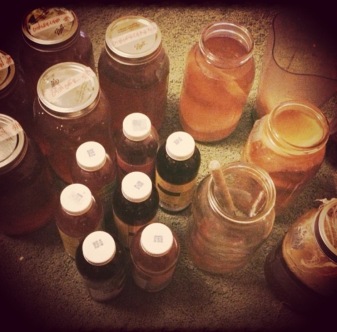I distinctly remember the first time I ever tried kombucha.
It was five years ago while I was living in Wisconsin. I was in the grocery store and was immediately sold on the look of the Synergy bottle that promised to reawaken, rebirth, repurpose, and redefine.

When I got to the car, I twisted the top off, took my first sip and spit it out without hesitation. It tasted rancid and vinegary…like it was some sort of tea that had turned so bad it had started to ferment (I guess there’s some truth to the fermentation part).
I don’t know how or when my hate turned to love but it did. Over time I grew what some people might call an unhealthy obsession with kombucha. I had a kind of “ah-ha” moment when I realized that the vinegary taste and carbonation were natural and suppose to be there. It was like accepting the moldy flavor of blue cheese. Or maybe overtime I just grew a strong affection for all things fermented and vinegary. It’s a mystery.
If you’ve never heard of this kombucha stuff, let me fill you in.

Kombucha is a fermented, effervescent drink that’s made from sweetened black or green tea. The sweet tea is fermented with a thing (or as we say in Spanish, an hongo) called a SCOBY (symbiotic culture of bacteria and yeast). I can best describe it as a wet, slimy pancake. Yummy. After the tea is fermented (the hongo consumes the sugar and releases carbonation), it becomes filled with a ton of great things for your body, including vitamins, enzymes, and bacteria that does a gut good.
The SCOBY
Some of the benefits of kombucha include:
- Improved Digestion (full of good bacterias that balance the digestion system)
- Weight Loss (improves metabolism, high in acetic acid like apple cider vinegar)
- Increased Energy (with B vitamins and enzymes)
- Immune Support (rich in antioxidants)
- Cancer Prevention (glucaric acid reduces cancer risk)
The days leading up to my departure for Costa Rica I drank as much kombucha as I could. When my mom called to see what I wanted from the store, it was kombucha. When I inconveniently stopped at Whole Foods on the way home, kombucha. Kombucha on tap? Yes please. I was drinking kombucha like I wasn’t going to see it for the next 2 years.
But to my sweet sweet fortune, I was gifted a SCOBY about 3 months ago from another volunteer. I carefully transferred it into a glass jar (the SCOBY doesn’t like plastic or metal) and carried it across the country all the way back to Fila Naranjo. I brewed me up a sweet tea and plopped in my SCOBY with an audience of skeptical and concerned community members and every since then, I’ve been making batch after batch of tasty, healthy, probiotic-rich kombucha.

Making kombucha is a rewarding, fun, hassle-free activity for even the non-hippiest of hippies out there. It’s healthy and cheap, and even though the recipe calls for sugar, the SCOBY consumes most of it, leaving the drink relatively low in calories (about 30 cals each glass) and high in vitamins, healthy enzymes and probiotics. What are you waiting for?
RECIPE
Kombucha:
- 6 cups of water
- 4 bags of green or black tea
- ½ cup of sugar (white sugar or organic cane sugar works best for me)
- ½ cup already made kombucha (called “starter”)
- 1 SCOBY
**The recipe can be doubled, tripled, etc.
- Boil 6 cups of water
- Combine boiling water, 4 tea bags and sugar
- Stir sugar until it dissolves and let the tea cool to room temperature. You can put the tea in the refrigerator or freezer to speed up the process.
- Once the sweet tea is cooled, remove the tea bags and combine with ½ cup starter and SCOBY in a glass container**.
- Cover the top of your container with cheese cloth or a coffee filter and secure with a rubber band or string.
- Let your mixture sit in a shaded, not-too-cold area for 1-2 weeks.
**Make sure your hands are clean when you are handling the SCOBY. Also the SCOBY does not like plastic or metal. If you need to stir anything or use a utensil, use a wooden spoon and always use a glass container. Respect the SCOBY.
Depending on your location and how you like your kombucha you will let your mixture sit for 1-2 weeks. The longer it sits, the more vinegary and pungent it can get. The kombucha will ferment faster in hotter climates. Where I live in Costa Rica, my kombucha is usually ready to drink between 7-9 days!
When your kombucha tastes to your liking, you can either drink it right away or do a second fermentation, which is pouring the kombucha into smaller bottles and letting it sit for another few days or up to a week(ish) time to gain more carbonation and flavor. Just make sure to include more sweetener (sugar, honey, raisins) for the probiotics to eat. Nomnom.
With a second fermentation, you can also add flavor to your kombucha like…
Mango Puree + Cane Sugar
Lemongrass + (Locally Grown) Honey
Passionfruit + Mint (from my garden)
This website has a lot of great ideas for second fermentation flavors but the world is your oyster and you can use anything including fresh fruits, dried fruits, herbs and spices. It’s fun to experiment!
In the process of turning the sweet tea into kombucha, the SCOBY will produce a baby (I know, it’s just amazing). With clean hands, you will handle your SCOBY with care and respect and slowly separate the two SCOBYs from each other. You can either throw one out or use the new one to exponentially grow your batches of kombucha. Just make sure you save some kombucha as the “starter” for your next batch.
If you live in the states and want to try making your own kombucha, ask your local health food store if they sell SCOBYs. You can also try making your own SCOBY with a recipe like this one.
If you’re a PCV in Costa Rica and want to try making kombucha, feel free to contact me for more information on getting a SCOBY.













Dang – such a good one again. and Double Dang – I want to make this.
LikeLike